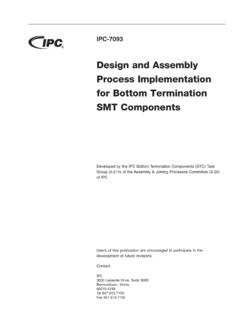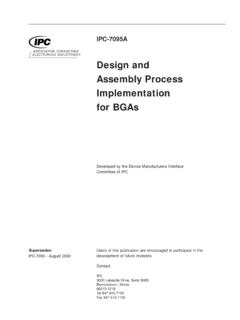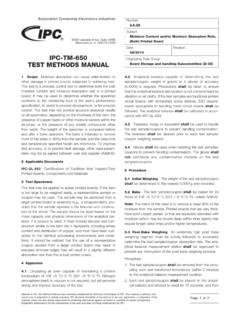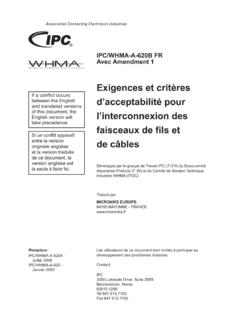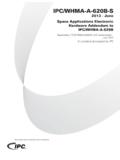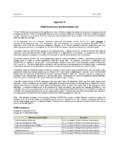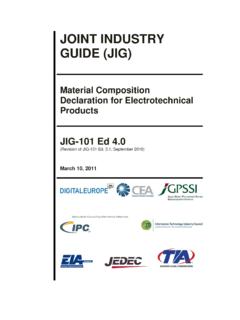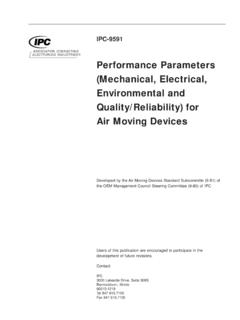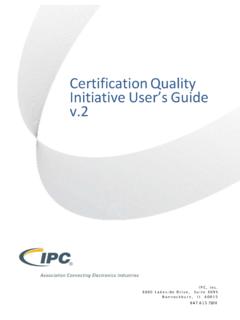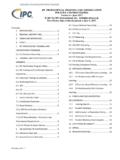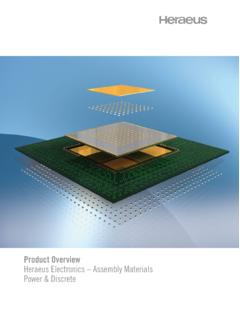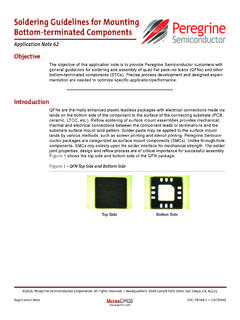Transcription of Requirements for Electronic Grade Solder Alloys and ... - IPC
1 IPC J-STD-006 CRequirements for ElectronicGrade Solder Alloys andFluxed and Non-FluxedSolid Solders for ElectronicSoldering ApplicationsDeveloped by the Solder Alloy Task Group (5-24c) of the Assemblyand Joining Committee (5-20) of IPCU sers of this standard are encouraged to participate in thedevelopment of future :IPC3000 Lakeside Drive, Suite 309 SBannockburn, IL 60015-1249 Phone (847) 615-7100 Fax (847) 615-7105 Supersedes:J-STD-006B w/Amendments1&2-October 2009J-STD-006B w/Amendment 1 -October 2008J-STD-006B - January 2006 Amendment 1 - June 2008J-STD-006A - May 2001J-STD-006 - January 1995 Amendment 1 - July 1996 TableofContents1 Scope .. Classification .. Alloy Composition .. Alloy Impurity Level .. Solder Form .. Dimensional Characteristics .. Flux Percentage and Metal Content.
2 Definition of Requirements .. Order of Precedence .. Conflict .. Clause References .. and Definitions .. and Safety .. 32 APPLICABLE Industry Standards .. Standards Organization (ISO) .. American Society for Testing and Materials(ASTM) .. 33 .. Composition .. Impurities .. D Alloys .. Forms and Dimensional Characteristics .. Solder .. Solder .. Solder .. Powder .. Form Solder .. Solder Characteristics .. Cored Solder .. Coated Solder .. Characteristics .. Percentage .. Classification .. Pool .. Residue Dryness .. for Product Identification .. 64 QUALITY ASSURANCE for Inspection .. for Compliance .. Assurance Program .. of Inspections .. Inspection .. Inspections .. Conformance Inspections.
3 Equipment and Inspection Facilities .. Conditions .. Routine .. Sampling .. of Solder Alloy for Test .. Cored Solder .. Wire Solder Up to Approximately 6 mm[ in] Diameter .. Solder and Other Wire Solder .. Reporting .. 85 PREPARATION FOR , Packing, and Packaging .. 86 .. Solder Product Packages .. and Ribbon Solders .. Solders .. Powder .. Spheres .. Standard Description of Solid SolderProducts .. Test for the Presence of Lead .. Labeling for Lead-Free and Leaded Marking,Symbols and Labels .. 10 Appendix A Solder 18 Appendix B Examples of InspectionReport 18 Appendix B-1 Test Report for Solder AlloyComposition and 18 July 2013 IPC-J-STD-006 CvAppendix B-2 Inspection Report for FluxedWire/Ribbon Solder IndividualInspection and Test 19 Appendix B-3 Inspection Report for Non-Fluxed Solder IndividualInspection and Test 20 Appendix B-4 Inspection Report forSolder 21 FiguresFigure 6-1 Recommended Lead Free Marking Symbol.
4 9 FiguresFigure 6-1 Recommended Lead Free Marking Symbol .. 10 TablesTable 3-1 Percentage by Mass of Impurity Elementsin Alloys .. 4 Table 4-1 Requirements and Inspection Routine .. 7 Table A-1 Composition, and Temperature Characteristicsof Lead-free Solder Alloys .. 11 Table A-2 Composition and Temperature Characteristicsof Common Tin-Lead Alloys .. 13 Table A-3 Composition and Temperature Characteristicsfor Specialty (non-Tin/Lead) Alloys .. 15 Table A-4 Cross-Reference from Solidus and LiquidusTemperatures to Alloy Names by Temperature .. 16 Table A-5 Cross-Reference from ISO 9453 Alloy Numbersand Designations to J-STD-006 Alloy Names .. 18 IPC-J-STD-006 CJuly 2013viRequirements for Electronic Grade SolderAlloys and Fluxed and Non-Fluxed SolidSolders for Electronic soldering Applications1 ScopeThis standard prescribes the nomenclature, Requirements and test methods for Electronic Grade Solder Alloys ;for fluxed and non-fluxed bar, ribbon, wire, and powder solders, for Electronic soldering applications ; and for special form (see ) Electronic Grade solders.
5 This is a quality control standard and is not intended to relate directly to the material sperformance in the manufacturing process. Solders for applications other than electronics should be procured using standard is one of a set of three joint industry standards that prescribe the Requirements and test methods for solderingmaterials for use in the electronics industry. The other two joint industry standards are:J-STD-004 Requirements for soldering FluxesJ-STD-005 Requirements for soldering ClassificationSoldering Alloys covered by this standard shall be classified by alloy composition and impurity level, Solder form and dimensional characteristics peculiar to the Solder form, flux percentage and flux classification, if classifications shall be used as part of the standard description of Solder products.
6 (See ) Alloy CompositionThe Solder Alloys covered by this standard include, but are not limited to, the Alloys listed inAppendix A, including pure tin and pure indium. Each alloy is identified by an alloy name, which is composed of a seriesof alphanumeric characters that identify the component elements in the alloy by chemical symbol and nominal percentageby percentage of each element in an alloy shall be determined by any standard analytical procedure with sufficient resolu-tion. Wet chemistry shall be used as the reference procedure. The tolerance & impurity levels of the alloy shall conform tothe current version of J-STD-006, or manufacturers designed alloy additions as agreed between user and supplier (AABUS) shall be identified as a fractionof the weight of the Alloy Impurity LevelThe allowable impurity level of the Solder Alloys covered by this standard is identified in for the description of Variation D Alloys .
7 The alloy variation letter D is added to the end of an alloy name andbecomes part of the alloy s Solder FormThe forms of Solder materials covered by this set of standards include paste (cream), bar, powder, rib-bon, wire and special Electronic Grade solders which do not fully comply with the Requirements of standard Solder alloysand forms listed herein. Some examples of special form solders are anodes, ingots, preforms, bars with hook and eye ends,and multiple-alloy Solder powders. A single-letter identifying symbol as defined below may be Paste (Cream)B BarD PowderR RibbonW WireS SpecialH Dimensional CharacteristicsStandard bar solders are further classified by unit mass. Wire solders are further clas-sified by wire size (outside diameter) and unit mass. Ribbon solders are further classified by thickness, width and unit solders are further classified by powder particle size distribution and unit mass.
8 See to 2013 IPC-J-STD-006C1
